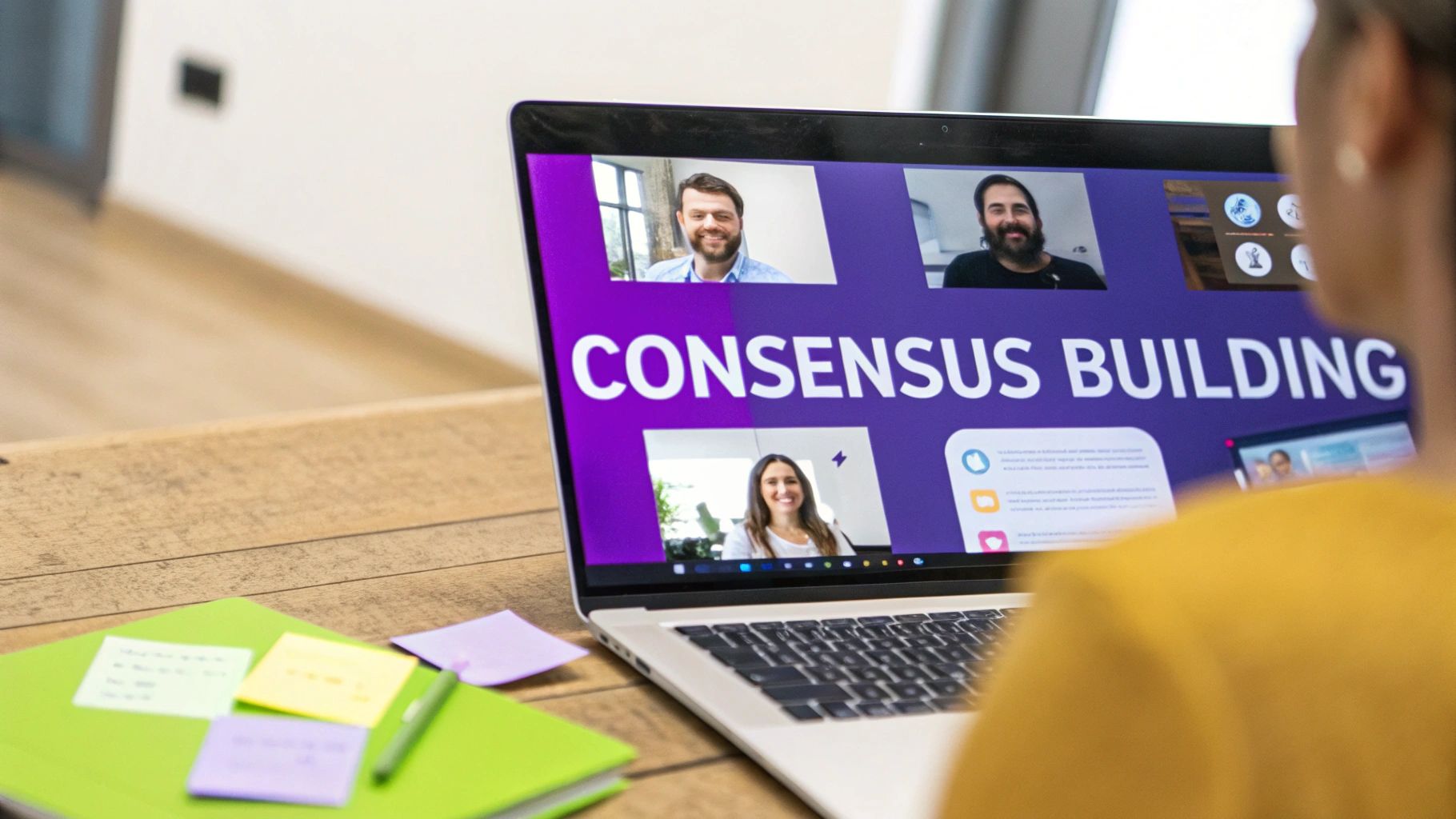In a remote-first world, getting everyone on the same page can feel like an impossible task. Misunderstandings multiply, strong opinions dominate, and true alignment remains elusive. The result? Stalled projects, disengaged teams, and missed opportunities. But what if you could transform this digital friction into focused momentum? The key lies in structured collaboration, not longer meetings. For remote teams especially, mastering effective communication is paramount. Learn how to better improve workplace communication to foster clearer discussions and shared understanding, which are critical for unlocking your team's collective genius.
This guide moves beyond theory and provides a practical toolkit of eight proven consensus building techniques, each meticulously adapted for the unique challenges of distributed work. We won't just tell you what they are; we'll show you how to implement them. You will get actionable steps for each method, from the Nominal Group Technique to the Delphi Method, and learn how to facilitate them effectively using virtual tools like Bulby. Our goal is to ensure every voice is heard, every perspective is considered, and your team moves forward with unified purpose and genuine buy-in. Get ready to move beyond chaotic video calls and start making decisions that stick.
1. Nominal Group Technique (NGT)
The Nominal Group Technique (NGT) is a structured brainstorming method that ensures all voices are heard, making it one of the most effective consensus building techniques for remote teams. It balances independent idea generation with collaborative refinement, preventing dominant personalities from swaying the outcome and giving introverted team members an equal platform.
Developed by Andre Delbecq and Andrew Van de Ven, NGT transforms a potentially chaotic brainstorming session into an orderly process. It has been used successfully in high-stakes environments, from NASA's mission planning to critical quality improvement initiatives in healthcare. The core principle is simple: separate the act of creating ideas from discussing them.
How NGT Works for Remote Teams
The process is straightforward and highly adaptable for virtual settings. It begins with a clearly defined question or problem. Participants then silently brainstorm and write down their ideas individually, using a digital whiteboard or a shared document. This independent phase is crucial as it promotes diverse, unfiltered thinking.
Once individual brainstorming is complete, the facilitator leads a round-robin session where each person shares one idea at a time, which is added to a collective list without immediate discussion. After all ideas are shared, the group reviews the list for clarification before moving to an anonymous vote to rank the top solutions.
A Visual Guide to the NGT Process
To help you visualize this structured approach, the infographic below outlines the three core phases of the Nominal Group Technique. It breaks down the workflow from silent brainstorming to the final ranked outcome.
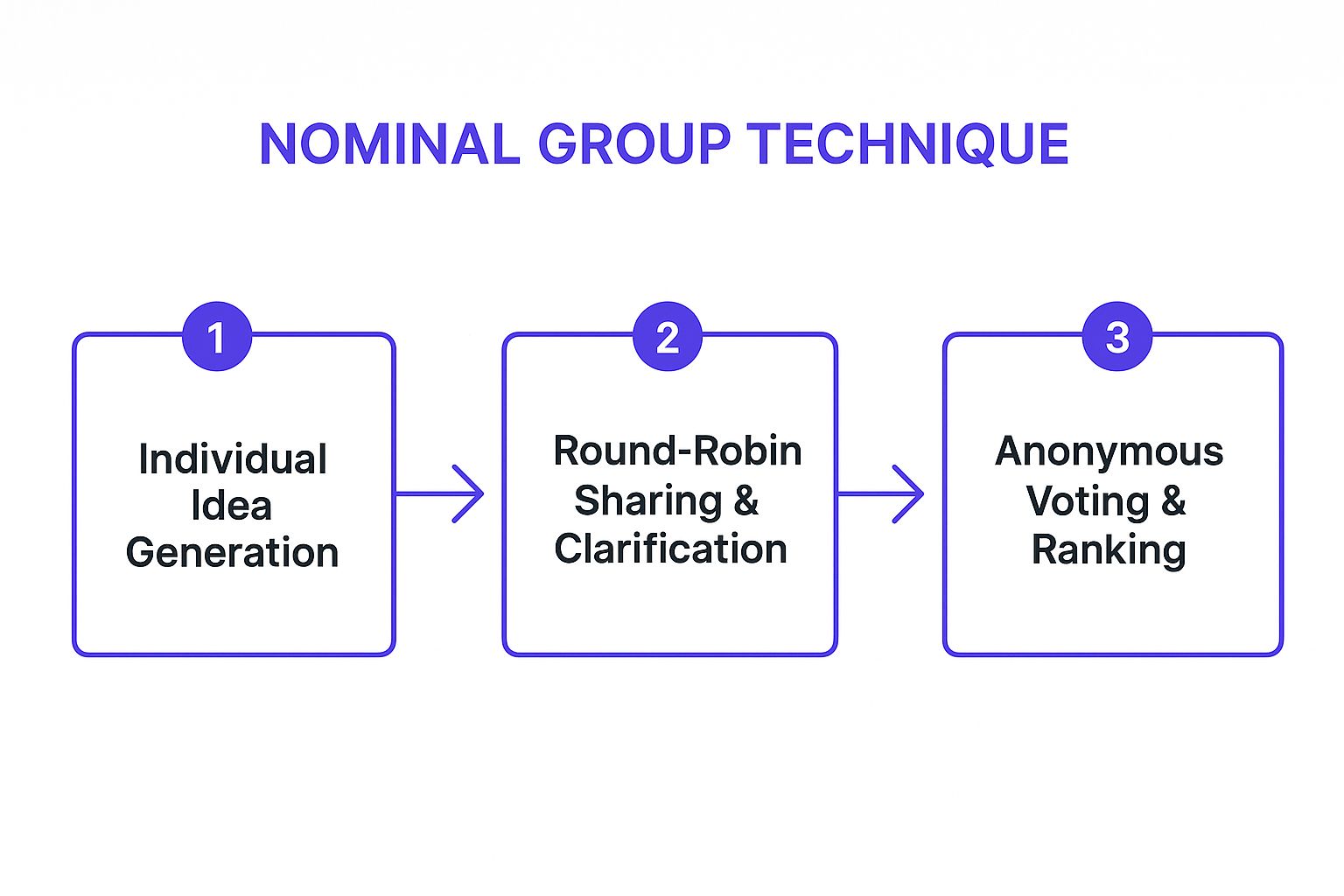
This visual guide highlights how the technique systematically narrows down options, ensuring the final decision is a product of collective, democratic input rather than just the loudest voice.
Actionable Tips for Implementing NGT
- Define the Problem Clearly: Start with a specific, well-framed question. A vague prompt like "How can we improve marketing?" is less effective than "What are three specific strategies we can launch next quarter to increase user sign-ups by 15%?"
- Use the Right Tools: For remote teams, leverage digital whiteboards like Miro or Mural for idea sharing. Use anonymous polling features in tools like Bulby, Zoom, or Slack for the voting phase.
- Keep Groups Small: NGT works best with 5-12 participants. This size is large enough for diverse ideas but small enough to manage a round-robin sharing session efficiently.
- Appoint a Strong Facilitator: The facilitator’s role is to enforce the process, keep time, and ensure discussions remain focused on clarification, not debate.
2. Delphi Method
The Delphi Method is an iterative forecasting and consensus building technique that gathers expert opinions through multiple rounds of anonymous surveys. It’s ideal for complex problems where objective data is scarce, allowing a group to converge on a consensus without the biases of face-to-face interaction or groupthink. This makes it a powerful tool for remote teams tackling strategic planning or future-focused challenges.
Originally developed by the RAND Corporation for military technology forecasting, its structured, asynchronous nature is perfectly suited for distributed teams. The method collects and distills anonymous judgments from a panel of experts, using controlled feedback to guide the group toward a final agreement. This process ensures that decisions are based on the collective intelligence of the group, not just the most persuasive argument.
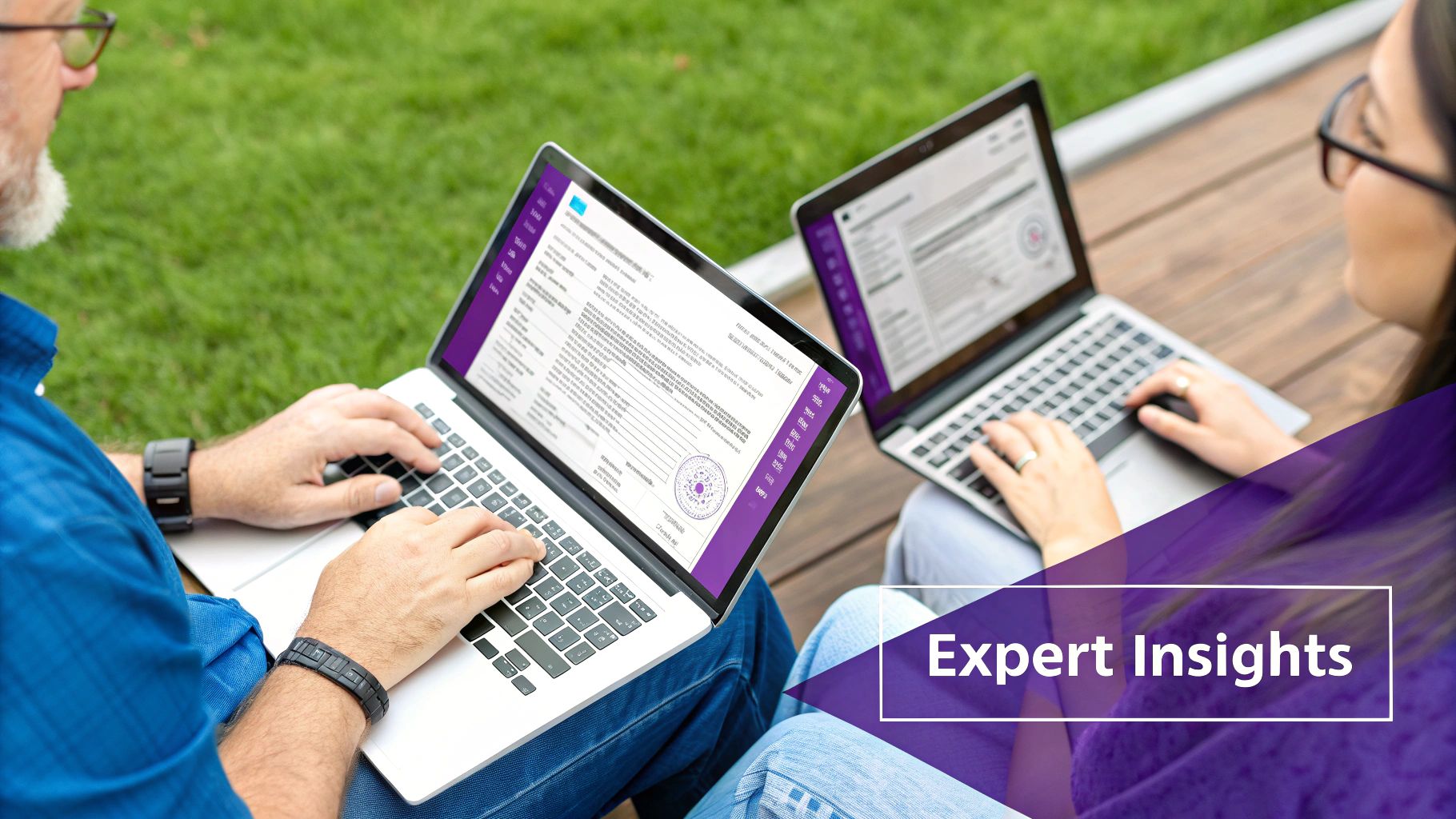
How the Delphi Method Works for Remote Teams
The process begins with a facilitator sending a questionnaire to a panel of carefully selected experts. These experts answer the questions anonymously and independently. The facilitator then aggregates the responses, summarizes them, and sends the summary back to the panel along with a second questionnaire.
Participants review the group's collective feedback and can revise their earlier opinions. This cycle repeats for a predetermined number of rounds (usually 3-4) until the group's responses converge and a stable consensus is reached. A key feature is the anonymity of participant responses, which can be achieved by learning how to create anonymous surveys effectively.
When to Use This Method
The Delphi Method is particularly effective for high-stakes, long-term decision-making where diverse expert input is critical. It shines in situations such as technology roadmapping, market trend forecasting, and establishing industry standards or guidelines. Its structured, asynchronous format is ideal for a creative problem solving process where deep, reflective thinking is more valuable than rapid-fire brainstorming.
Actionable Tips for Implementing the Delphi Method
- Select Diverse Experts: Choose participants with varied and credible expertise relevant to the problem. Their diversity will enrich the quality of the insights gathered.
- Design Clear Questions: Your questions must be unambiguous and specific to avoid misinterpretation. A well-designed questionnaire is the foundation of a successful outcome.
- Provide Meaningful Summaries: The facilitator must skillfully summarize the results between rounds, highlighting areas of agreement and disagreement without introducing bias.
- Limit the Rounds: Stick to 3-4 rounds to maintain participant engagement. Too many cycles can lead to fatigue and drop-offs.
- Set Realistic Timelines: Clearly communicate the timeline for each round and the overall process to keep experts committed and on track.
3. Multi-Criteria Decision Analysis (MCDA)
Multi-Criteria Decision Analysis (MCDA) is a systematic approach for evaluating complex options that have multiple, often conflicting, objectives. It provides a logical framework for consensus building by breaking down a major decision into smaller, more manageable parts, making it ideal for remote teams facing high-stakes choices. This technique ensures that the final decision is transparent, defensible, and aligned with collective priorities.
Pioneered by thinkers like Thomas Saaty and Bernard Roy, MCDA is used extensively in fields like corporate supplier selection and European Union environmental policy. The core strength of MCDA is its ability to transform subjective stakeholder preferences into an objective, data-driven ranking. It moves the conversation from "which option feels right?" to "which option best satisfies our most important criteria?"
How MCDA Works for Remote Teams
The process begins with collaboratively identifying all relevant criteria for making the decision. For example, when choosing a new software vendor, criteria might include cost, security, ease of use, and customer support. The team then assigns a weight to each criterion to reflect its relative importance. This step is critical for aligning on priorities.
Next, each alternative is scored against every criterion. A facilitator can lead this process using shared spreadsheets or dedicated decision-making tools. The weighted scores are then mathematically aggregated to produce an overall score for each option, revealing the most logical choice. This structured method prevents emotional biases from derailing the decision-making process.
Actionable Tips for Implementing MCDA
- Involve Stakeholders in Criteria Development: To ensure buy-in, collaborate with all key stakeholders to define the decision criteria. Use a virtual workshop to brainstorm and finalize the list together.
- Use Workshops to Establish Weights: Assigning weights is a powerful consensus-building exercise. A facilitated discussion helps the team align on what truly matters before evaluating the options.
- Keep Scoring Scales Simple: Use a consistent and simple scale, like 1-5 or 1-10, for scoring each alternative against the criteria. This simplifies the process and reduces confusion.
- Document All Assumptions Clearly: Keep a record of why specific criteria were chosen and how weights were assigned. This transparency is vital for justifying the final decision later. Learn more about related decision-making frameworks to strengthen your approach.
4. Open Space Technology
Open Space Technology (OST) is a self-organizing meeting format where participants create and manage their own agenda around a central, strategic theme. This technique is designed to foster passionate engagement and organic conversation, making it a powerful tool for building consensus on complex or urgent issues. By empowering participants to take ownership of the agenda, OST ensures that the most important topics are discussed by the people who care about them most.
Created by Harrison Owen, this method operates on simple yet profound principles, such as "whoever comes are the right people" and the "law of two feet," which encourages individuals to move freely between discussions they find valuable. OST has been successfully used to drive organizational change at companies like Microsoft and in community visioning processes worldwide, proving its effectiveness in diverse, large-scale settings.
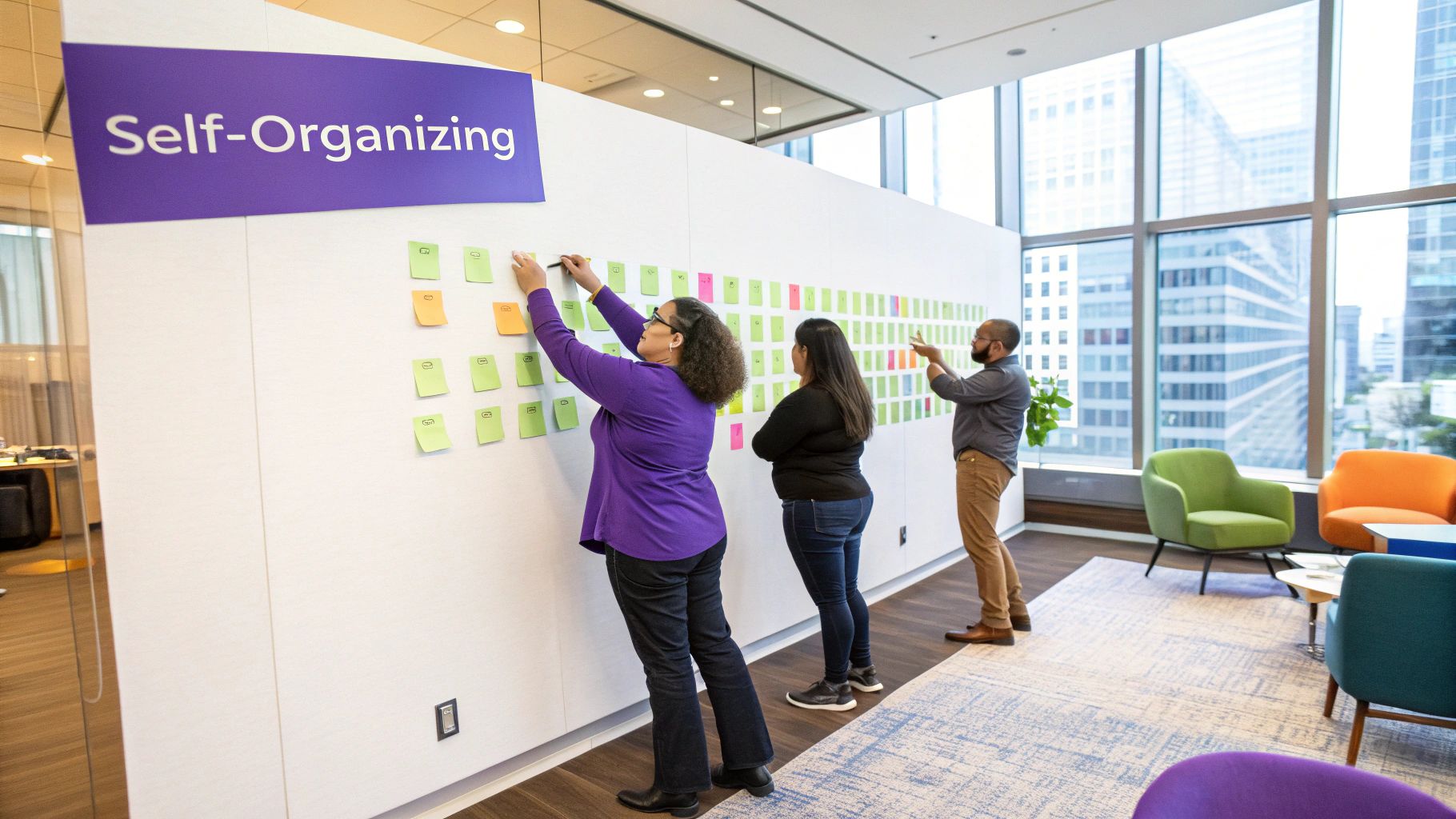
How Open Space Technology Works for Remote Teams
In a virtual environment, OST begins with a facilitator presenting a compelling central question. Participants then propose session topics they are passionate about leading or discussing, adding them to a shared digital agenda board, often called the "marketplace." This creates a dynamic schedule of parallel breakout sessions.
Attendees are free to move between virtual breakout rooms, contributing where they can and learning where they are interested. The "law of two feet" translates perfectly to a remote setting: if you are not learning or contributing, you can simply join another virtual room. Notes from each session are captured in shared documents, creating a collective record of insights and action items that forms the basis for group consensus.
Actionable Tips for Implementing OST
- Start with a Compelling Theme: Frame a central question that is broad enough to inspire diverse topics but focused enough to provide direction. For example, "What are the most critical innovations we need to pursue in the next two years?"
- Trust the Process: The biggest challenge is often for leaders to resist over-facilitating. Allow the agenda to emerge organically and trust participants to manage their own time and contributions effectively.
- Leverage Breakout Rooms: Use the breakout room features in platforms like Zoom or Microsoft Teams to create spaces for the self-managed sessions. A central hub or main room should remain open for coordination.
- Use a Shared Digital Space: A tool like Miro, Mural, or even a simple Google Doc can serve as the "marketplace" for posting topics and as a repository for session notes, ensuring all outcomes are captured and shared.
5. World Café Method
The World Café method is a conversational process designed to foster collaborative dialogue and build collective intelligence. It's an excellent consensus building technique for exploring complex challenges by linking diverse perspectives in a dynamic, informal setting. It mimics the environment of a café where small, intimate conversations spark new ideas and connections.
Developed by Juanita Brown and David Isaacs, this method has been successfully used in large-scale strategic planning sessions at companies like HP and DaimlerChrysler, as well as in community planning and healthcare reform. The core idea is that through structured, small-group conversations that cross-pollinate, a group can uncover shared meaning and discover novel solutions together.
How The World Café Works for Remote Teams
The process brings people together in a series of short, structured conversational rounds. Participants are divided into small groups (tables), each with a specific question to discuss. After a set time, one person remains as the "table host" while others move to different tables, carrying ideas from their previous conversation to the new one. This cross-pollination is key to building shared understanding.
For remote teams, this is facilitated using breakout rooms in video conferencing tools. A main session serves as the "café," and digital whiteboards or shared documents act as the "tablecloths" where key insights are captured. The facilitator ensures participants rotate between breakout rooms, and table hosts summarize previous discussions for newcomers.
A Visual Guide to the World Café Process
To help you visualize this conversational flow, the image below illustrates the setup of the World Café. It shows how participants engage in small group dialogues and then move between tables to weave together a collective tapestry of ideas.
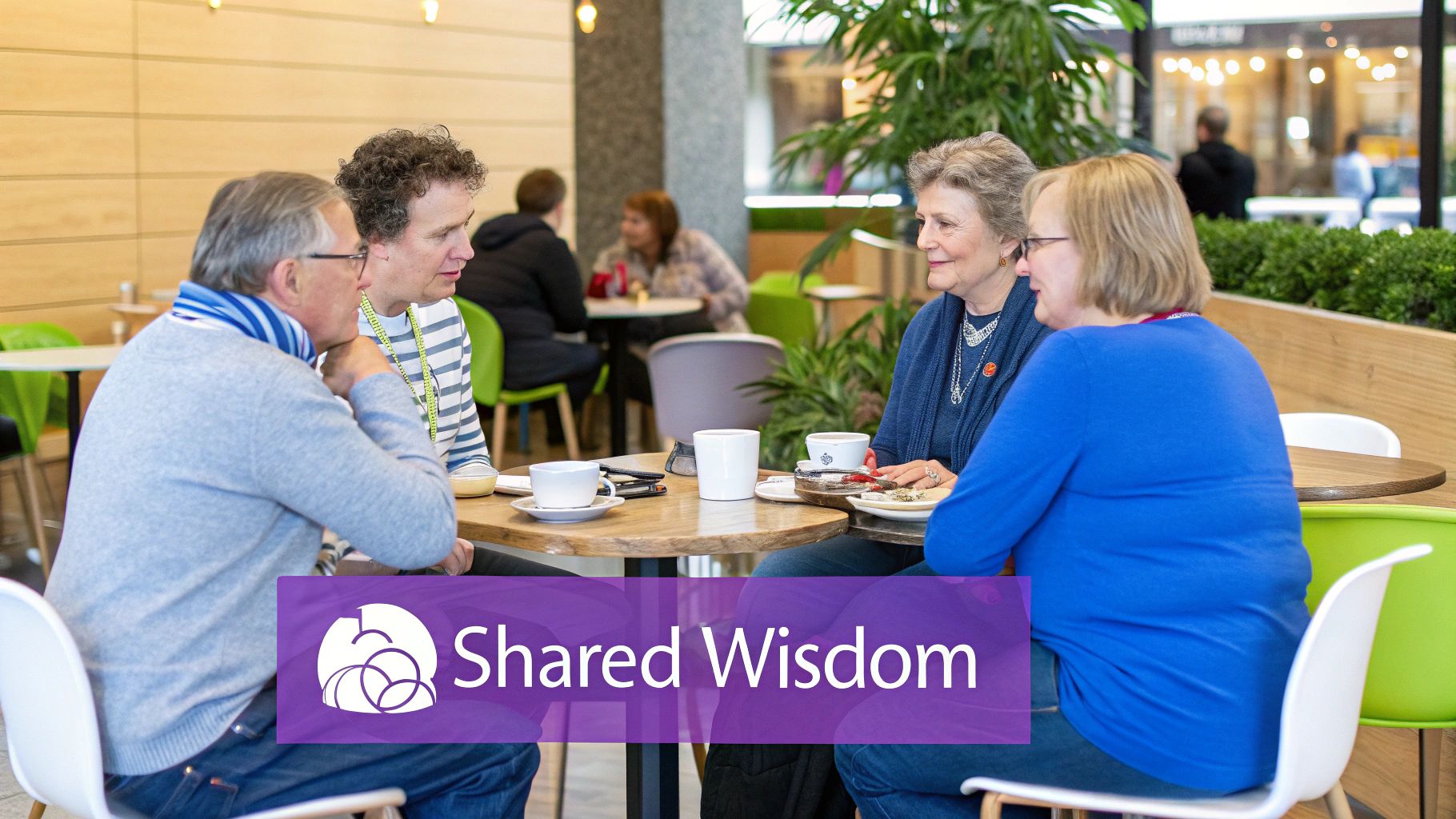
This visual represents how the technique creates a living network of conversation, where insights from one discussion enrich the next, leading to a synthesized, collective perspective.
Actionable Tips for Implementing the World Café Method
- Design Powerful Questions: The success of a World Café depends on the quality of your questions. They should be open-ended and relevant to the participants. For example, instead of "How can we increase sales?" ask "What possibilities for growth emerge when we think about our customers' deepest needs?"
- Create a Hospitable Space: Even remotely, foster a welcoming atmosphere. Use icebreakers, encourage cameras on, and ask participants to create a comfortable space for themselves. This psychological safety encourages open sharing.
- Appoint and Brief Table Hosts: Table hosts are crucial. They welcome newcomers to their breakout room, briefly share the essence of the last conversation, and encourage everyone to record key ideas on the shared digital whiteboard.
- Harvest the Collective Insights: After the rounds, bring everyone back to the main session for a "harvest." This is where patterns, themes, and key insights from all tables are shared and synthesized, forming the foundation for consensus.
6. Appreciative Inquiry
Appreciative Inquiry (AI) is a strength-based consensus building technique that flips the traditional problem-solving model on its head. Instead of focusing on deficits and what’s broken, it guides teams to build on what’s working well, energizing participants and fostering a positive, collaborative environment. It’s particularly effective for remote teams looking to drive large-scale change or reinvigorate their mission.
Developed by David Cooperrider at Case Western Reserve University, Appreciative Inquiry has been used to guide organizational transformation at companies like British Airways and to facilitate major community development projects. The core principle is that organizations and teams move in the direction of what they study. By focusing on strengths and successes, teams naturally build consensus around a shared, positive future.
How Appreciative Inquiry Works for Remote Teams
AI follows a structured "4-D Cycle": Discovery, Dream, Design, and Destiny. The process begins with asking compelling, positive questions to discover the team’s "positive core." For remote teams, this can be done through one-on-one interviews via video calls or structured surveys using tools like Bulby to collect inspiring stories.
In the Dream phase, the team collectively imagines its ideal future based on the strengths uncovered. This is followed by the Design phase, where they co-create tangible proposals and systems to make that dream a reality. Finally, the Destiny phase involves committing to actionable steps. This entire cycle fosters consensus not by debating problems, but by co-creating a future everyone is excited to build.
Actionable Tips for Implementing Appreciative Inquiry
- Frame Compelling Questions: Start with positive, open-ended questions. Instead of "What's wrong with our workflow?" ask "Describe a time when our team collaborated flawlessly. What made it possible?"
- Share Inspiring Stories: Use shared documents or virtual town halls to collect and share powerful stories of success from the Discovery phase. This builds momentum and collective pride.
- Connect Dreams to Design: Ensure the aspirational ideas from the Dream phase are translated into concrete, practical design elements. A shared vision is powerful, but it needs a clear action plan.
- Involve Diverse Stakeholders: AI is most effective when it includes a wide range of voices. Invite members from different departments, roles, and tenures to participate in the process.
7. Consensus Decision Making
Consensus Decision Making is a collaborative process where the goal is to reach a decision that all participants can support. Unlike majority rule, this technique avoids a "win-lose" outcome by modifying proposals until they meet the essential needs of every group member, making it one of the most inclusive consensus building techniques available.
Rooted in practices from Quaker communities and various Indigenous cultures, this method prioritizes unity and collective agreement. It is built on the belief that a solution everyone can live with is stronger and more sustainable than one that a minority opposes. The focus is on finding common ground through dialogue, creative problem-solving, and shared responsibility.
How Consensus Decision Making Works for Remote Teams
For remote teams, this process requires a highly structured and facilitated discussion. It begins with a clear proposal. The facilitator then guides the group through rounds of discussion to identify concerns, potential issues, and areas of disagreement. Participants work together to amend the proposal, addressing each concern until no one has a fundamental objection.
This method emphasizes listening and empathy. Instead of debating to win, team members explore perspectives to find a synergistic solution. The final decision is reached not when everyone agrees it's their favorite option, but when everyone agrees they can support it and help implement it successfully. This is a key distinction in various group decision making techniques.
A Visual Guide to the Consensus Process
To help you understand this collaborative approach, the infographic below outlines the key stages of Consensus Decision Making. It illustrates the journey from presenting an initial proposal to achieving full group agreement.
This visual guide shows how consensus is not about a simple vote but a cycle of discussion and refinement that builds collective ownership over the final outcome.
Actionable Tips for Implementing Consensus Decision Making
- Establish Clear Process Agreements: Before you start, agree on the rules. Define what consensus means for your team (e.g., "I can live with it") and what happens if someone "blocks" a proposal.
- Invest in Facilitation: A skilled facilitator is crucial to keep the conversation productive, ensure all voices are heard, and guide the group through conflicts without letting them derail the process.
- Address Conflicts Early and Directly: Consensus requires tackling disagreements head-on in a constructive way. Encourage team members to voice concerns early rather than letting them fester.
- Practice with Low-Stakes Decisions: Build your team's consensus "muscle" by using this technique for smaller, less critical decisions first. This helps everyone get comfortable with the process before tackling high-stakes issues.
8. Technology of Participation (ToP)
The Technology of Participation (ToP) is a comprehensive suite of facilitation methods designed to foster inclusive participation and build deep, lasting consensus. Developed by the Institute of Cultural Affairs (ICA), ToP is one of the most robust consensus building techniques because it provides structured processes for every stage of group work, from discussion to strategic planning.
ToP is more than just a single technique; it's a holistic methodology. Its core methods, like the Focused Conversation Method and the Workshop Method, are used globally in corporate strategic planning, government policy development, and large-scale community initiatives. The methodology is built on the principle that genuine consensus arises when a group moves together through a natural human thought process: from objective data to emotional reactions, then to interpretation, and finally to decisive action.
How ToP Works for Remote Teams
ToP methods are highly adaptable for virtual environments. The Focused Conversation Method, often called the ORID model, guides discussions through a four-level sequence of questions: Objective (facts), Reflective (feelings/associations), Interpretive (meaning/significance), and Decisional (next steps). For remote teams, a facilitator can pose these questions sequentially in a shared document or on a digital whiteboard, allowing participants to add their thoughts at each level before moving on.
The Workshop Method is ideal for more complex planning. It guides a group through creating a shared vision, identifying underlying obstacles, and developing strategic actions. This structured flow prevents conversations from getting derailed and ensures that the final plan is co-created and fully owned by the entire team, making it a powerful tool for aligning distributed groups.
Actionable Tips for Implementing ToP
- Master the ORID Model: The foundation of ToP is the ORID questioning framework. Thoroughly understand how to craft and sequence questions to guide a group's thinking process effectively.
- Adapt the Language: While the framework is universal, the specific wording of questions should be adapted to fit your team's culture and the context of the discussion.
- Focus on the Process: Trust the structured process to lead the group to consensus. A facilitator's role is not to provide answers but to guide the group through the method.
- Build in Reflection Time: The "Reflective" stage is crucial. Give participants adequate silent time to consider their feelings and associations before sharing, which is easily managed in a remote setting. Improving your skills in this area is key; you can explore comprehensive facilitation skills training to become a more effective ToP practitioner.
Consensus Techniques Comparison Matrix
| Method | Implementation Complexity 🔄 | Resource Requirements ⚡ | Expected Outcomes 📊 | Ideal Use Cases 💡 | Key Advantages ⭐ |
|---|---|---|---|---|---|
| Nominal Group Technique (NGT) | Medium: Structured phases needing skilled facilitation | Moderate: Requires facilitator and prepared voting system | Quantitative ranked ideas, balanced participation | Complex problems needing creative solutions and equal input | Prevents vocal domination, reduces groupthink, efficient time use |
| Delphi Method | High: Multiple iterative survey rounds, expert coordination | High: Expert panel commitment over weeks/months | Converged expert consensus with documented reasoning | Long-term forecasting, policy, expert judgment on uncertainty | Eliminates conflicts/status bias, allows remote participation |
| Multi-Criteria Decision Analysis (MCDA) | High: Mathematical modeling, criteria weighting | High: Stakeholder workshops and data collection | Transparent, auditable decisions balancing multiple criteria | Complex multi-stakeholder decisions, policy, strategic planning | Explicit trade-offs, reduces bias, sensitivity analysis |
| Open Space Technology | Low-Medium: Self-organized, minimal predefined structure | Low: Minimal planning, flexible physical setup | High engagement, organic consensus, participant ownership | Organizational change, strategic visioning, creative solutions | High energy, flexible, addresses passionate issues |
| World Café Method | Medium: Facilitated small group rotations and setup | Medium: Requires space and graphic recording tools | Collective intelligence, shared understanding | Large group strategic conversations and community engagement | Builds shared wisdom, democratic participation |
| Appreciative Inquiry | Medium: Strength-based interview and visioning cycles | Medium: Skilled facilitators, stakeholder involvement | Positive energy, collective vision, mobilized action | Organizational change, community development | Builds on strengths, reduces defensiveness, hopeful approach |
| Consensus Decision Making | High: Facilitated discussion, conflict resolution | Medium-High: Skilled facilitators, time investment | Strong buy-in, collaborative solutions, group cohesion | Cooperative groups, shared values, strong commitment decisions | Ensures all voices heard, reduces resistance, fosters trust |
| Technology of Participation (ToP) | High: Structured facilitation methods with ORID and workshops | Medium-High: Training required, adaptable to group sizes | Systematic participation, balanced analytical and creative input | Strategic planning, team development, diverse group facilitation | Proven cross-cultural success, reduces bias, builds capacity |
From Theory to Teamwork: Putting Consensus into Practice
Navigating the complexities of group decision-making can feel like an uphill battle, especially for remote teams. The eight powerful consensus building techniques we’ve explored, from the structured silence of the Nominal Group Technique to the dynamic energy of the World Café, offer a clear roadmap. They provide the frameworks needed to move beyond endless debates and stalemates.
The core lesson is this: true consensus isn't about compromise where everyone loses a little. It's about a collective journey toward a solution that everyone can genuinely support and commit to. Each method provides a unique path to get there, tailored for different challenges and team dynamics. Whether you need to generate and rank ideas quickly with NGT or explore complex, systemic issues with Open Space Technology, you now have a toolkit to guide your team's conversations productively.
Key Takeaways for Your Team
Mastering these techniques requires more than just reading the steps. It's about cultivating a new collaborative mindset. Here are the most critical takeaways to put into practice:
- Structure Liberates, Not Constrains: The rules and phases of these methods are not bureaucratic hurdles. They are designed to level the playing field, mitigate common cognitive biases like groupthink, and ensure that quieter voices are heard alongside dominant ones.
- Process Over Personalities: By focusing on a shared, transparent process, you shift the team's energy away from personal opinions and office politics. The focus becomes a collective effort to follow the framework and trust the outcome, leading to more objective and robust decisions.
- Adaptation is Essential: No single technique is a silver bullet. The real skill lies in understanding your team’s specific challenge and choosing the right tool for the job. Don't be afraid to adapt a method to better fit your team's culture, timeline, and the specific decision at hand.
Your Actionable Next Steps
Transforming your team's approach to decision-making starts with a single, deliberate step. Instead of trying to implement everything at once, choose one technique that resonates with a current challenge your team is facing.
Is your team stuck in a brainstorming rut? Try the Nominal Group Technique in your next meeting. Are you facing a complex, long-term strategic decision? Consider a modified, asynchronous Delphi Method. Announce your intention to the team, explain the process clearly, and gather feedback afterward. This small experiment can build the confidence and momentum needed to integrate these powerful collaborative habits into your team's DNA.
Ultimately, adopting these consensus building techniques is an investment in your team’s long-term health and performance. It fosters a culture of psychological safety, where every member feels valued and heard. This creates a powerful foundation of shared ownership and commitment, turning decisions into collective victories and equipping your remote team to solve any challenge that comes its way.
Ready to put these techniques into action without the manual setup? Bulby provides guided workflows and digital tools specifically designed for structured collaboration, making it easy to facilitate methods like the Nominal Group Technique and more. Sign up for free at Bulby and start building stronger consensus with your remote team today.

